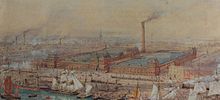Barrow Jute Works


The Barrow Jute Works was a
The mill's all female workforce peaked at 2,000, many of whom were Irish immigrants.[2] The jute fabrics produced were used for a wide range of items including telegraph cables, ropes and artificial hair, later including the production of Kalemeit for carpets, rugs and window drapery.[3] The quality of produce was acknowledged in 1878 at the Exposition Universelle in Paris, France where the Barrow and Calcutta Jute Company was awarded a gold medal in the field.[3]
Two fires damaged the works during its history - 1879 and 1892, the latter occasion destroying half of the mill that was never rebuilt.[2] Competition from the Indian jute trade as well as the large jute works in Dundee led to the mill's ultimate demise.[2] Barrow Jute Works' iconic chimney was demolished in 1930, followed by the offices in 1948.
The site is now occupied by
See also
References
- ^ North West Evening Mail. Archived from the originalon 21 April 2013. Retrieved 10 March 2013.
- ^ a b c d "Archaeological Assessment Report Barrow" (PDF). English Heritage. Retrieved 10 March 2013.
- ^ a b c d "Barrow Flax and Jute Co". Grace's Guide. Retrieved 10 March 2013.
